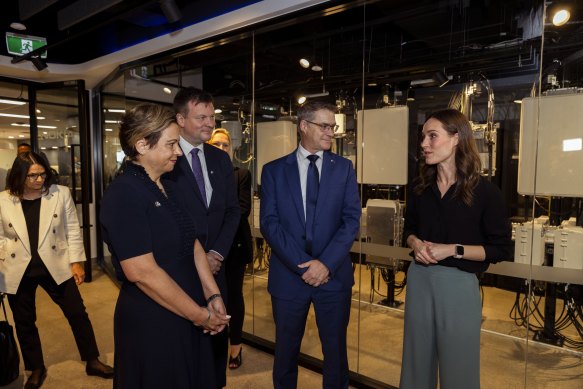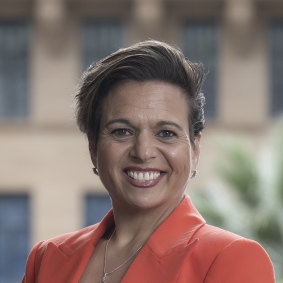- Exclusive
- Business
- Companies
- Telecommunications
This was published 2 years ago
‘We’ve come full circle’: Labor declares regulatory reset of NBN
By Jessica Yun
Communications Minister Michelle Rowland has defended the Labor government’s policy to return the national broadband network closer to its original design despite fresh admissions it will not be able to recover $31 billion invested into the project.
Speaking alongside Finland’s Prime Minister Sanna Marin, as the pair announced a major upgrade that aims to boost internet speeds for 7 million Australians by 100 times, Rowland said the current government’s policy would future-proof the NBN.
“I think by coming in, myself and Finance Minister [Katy] Gallagher as shareholder ministers, we have effectively undertaken a regulatory reset,” Rowland said.
“We will keep the NBN in public ownership for the foreseeable future whilst we finish this job of making it a better network.”

Communications Minister Michelle Rowland; Finnish Minister for Development Cooperation and Foreign Trade Ville Skinnari; Nokia Chief Customer Experience Officer Ricky Corker; and Prime Minister of Finland Sanna Marin at the launch of a new, faster generation of NBN infrastructure that is being rolled out by Nokia.Credit: Dominic Lorrimer
Rowland’s comments come after NBN Co admitted in a newly submitted pricing proposal that it will not be able to recover $31 billion in regulatory costs attached to the initial build of the network.
Under the new model, NBN Co will charge telcos such as Telstra and Optus much lower wholesale prices, which have been a major point of contention between the telecommunications industry and the industry.
The NBN was first announced by the Rudd Government in 2009 and was intended to provide fibre network coverage for 93 per cent of Australian homes and businesses. In 2014, under the new Coalition government, then-Communications Minister Malcolm Turnbull said the roll-out would switch from a primarily fibre-to-premises model to a mix of different technologies. The NBN currently involves six different underlying technologies.
Rowland took aim at the Coalition government over its decision to use Telstra’s copper network for fibre-to-the-node (FTTN) connections which she said had resulted in cost blowouts and made the NBN less reliable.

Communications Minister Michelle Rowland.Credit: Louie Douvis
“The copper network is susceptible to more faults, particularly in times of floods and other disasters – its resilience is really compromised, and that’s certainly a key issue, and it costs more to maintain.”
“But fibre [to every home] has always been a Labor initiative. We’ve come full circle here today,” Rowland said. “We are absolutely committed to upgrading the network to providing more access to fibre rather than copper.”
Rowland added the Labor government will continue to commit more money to the fixed wireless network to boost connectivity for people living in the bush, saying that improvements would encourage people on the satellite network to switch.
“It really is a virtuous cycle. As you update more people to fibre, you can ensure the fixed wireless network is updated, it also means satellite services becomes a better user experience as well.”
The new deal between Nokia and NBN will deliver greater volumes of data to consumers at higher speeds. Nokia’s technology will see those on fibre-to-the-premises (FTTP) networks, and people who join FTTP in future, be able to access multi-gigabit speeds. The NBN can currently only accommodate up to 1 gigabit per second, but the new Nokia infrastructure will increase this to up to 100 gigabits per second.
At a tour of Nokia’s 5G Innovation Lab, Finland Prime Minister Sanna Marin said she was pleased about the cooperation between Australia and the 157-year-old Nordic company.
“We have to make sure that when we are digitalised in our societies, we are doing it in a secure and safe way,” Marin said.
The 10-year partnership for an undisclosed sum between the two companies will make NBN the first operator in the Southern Hemisphere to roll out Nokia’s technology.
The Business Briefing newsletter delivers major stories, exclusive coverage and expert opinion. Sign up to get it every weekday morning.